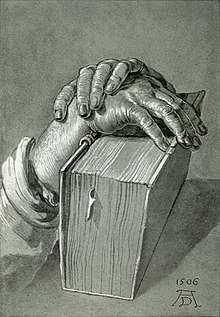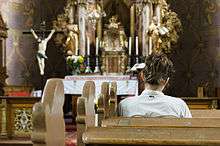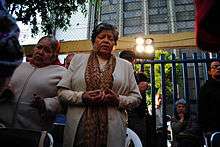Christian prayer
| Part of a series on |
| Christianity |
|---|
 |
|
|
|
Prayer is an important activity in Christianity, and there are several different forms of Christian prayer.[1]
Christian prayers are diverse: they can be completely spontaneous, or read entirely from a text, like the Anglican Book of Common Prayer. The most common prayer among Christians is the "Lord's Prayer", which according to the gospel accounts (e.g. Matthew 6:9-13) is how Jesus taught his disciples to pray.[2] "The Lord's Prayer" is a model for prayers of adoration, confession and petition in Christianity.[2]
A broad, three stage characterization of prayer begins with vocal prayer, then moves on to a more structured form in terms of meditation, then reaches the multiple layers of contemplation,[3][4] or intercession.
There are two basic settings for Christian prayer: corporate (or public) and private. Corporate prayer includes prayer shared within the worship setting or other public places. These prayers can be formal written prayers or informal extemporaneous prayers. Private prayer occurs with the individual praying either silently or aloud within a private setting. Prayer exists within multiple different worship contexts and may be structured differently. These types of contexts may include:
Liturgical: Often seen within the Catholic Church. This is a very orthodox service, according to Catholics. Within a Catholic Mass, which is an example of a liturgical form of worship, there are bible readings and a sermon is read.
Often seen within the Holy Orthodox Church. The Holy Bible is read and a sermon is read.
Non- Liturgical: Often seen within Evangelical church, this prayer is often not scripted and would be more informal in structure. Most of these prayers would be extemporaneous.
Charismatic: Often seen within gospel churches. It is the main form of worship in Pentecostal churches. It usually includes song and dance, and may include other artistic expressions. There may be no apparent structure, but the worshippers will be "led by the Holy Spirit".
Background

Prayer in the New Testament is presented as a positive command (Colossians 4:2; 1 Thessalonians 5:17). The people of God are challenged to include prayer in their everyday life, even in the busy struggles of marriage (1 Corinthians 7:5) as it is thought to bring the faithful closer to God.
Throughout the New Testament, prayer is shown to be God's appointed method by which the faithful obtain what he has to bestow (Matthew 7:7-11; Matthew 9:24-29; Luke 11:13).
Prayer, according to the Book of Acts, can be seen at the first moments of the church (Acts 3:1). The apostles regarded prayer as an essential part of their lives (Acts 6:4; Romans 1:9; Colossians 1:9). As such, the apostles frequently incorporated verses from Psalms into their writings. Romans 3:10-18 for example is borrowed from Psalm 14:1-3 and other psalms.
Thus, due to this emphasis on prayer in the early church. lengthy passages of the New Testament are prayers or canticles (see also the Book of Odes), such as the Prayer for forgiveness (Mark 11:25-26), the Lord's Prayer, the Magnificat (Luke 1:46-55), the Benedictus (Luke 1:68-79), Jesus' prayer to the one true God (John 17), exclamations such as, "Praise be to the God and Father of our Lord Jesus Christ" (Ephesians 1:3-14), the Believers' Prayer (Acts 4:23-31), "may this cup be taken from me" (Matthew 26:36-44), "Pray that you will not fall into temptation" (Luke 22:39-46), Saint Stephen's Prayer (Acts 7:59-60), Simon Magus' Prayer (Acts 8:24), "pray that we may be delivered from wicked and evil men" (2 Thessalonians 3:1-2), and Maranatha (1 Corinthians 16:22).
Types of prayer


Liturgical prayers
Elements of the oldest Christian prayers may be found in liturgies such as the Roman Catholic Mass, the Orthodox Divine Liturgy, the Anglican Book of Common Prayer, and the Lutheran Book of Worship.
Seasonal prayers
Many denominations that adhere to a liturgical tradition use specific prayers geared to the season of the Liturgical Year, such as Advent, Christmas, Lent and Easter. Some of these prayers are found in the Roman Breviary, the Liturgy of the Hours, the Orthodox Book of Needs and the Anglican Book of Common Prayer.
Prayer to saints
The ancient church, in both Eastern Christianity and Western Christianity, developed a tradition of asking for the intercession of (deceased) saints, and this remains the practice of most Eastern Orthodox, Oriental Orthodox, Roman Catholic, and some Anglican churches. Churches of the Protestant Reformation however rejected prayer to the saints, largely on the basis of the sole mediatorship of Christ.[5] The reformer Huldrych Zwingli admitted that he had offered prayers to the saints until his reading of the Bible convinced him that this was idolatrous.[6]
Meditation and contemplative prayer

Christian meditation is a structured attempt to get in touch with and deliberately reflect upon the revelations of God.[7] The word meditation comes from the Latin word meditārī, which has a range of meanings including to reflect on, to study and to practice. Christian meditation is the process of deliberately focusing on specific thoughts (such as a bible passage) and reflecting on their meaning in the context of the love of God.[8]
Christian meditation aims to heighten the personal relationship based on the love of God that marks Christian communion.[9][10]
At times there may be no clear-cut boundary between Christian meditation and Christian contemplation, and they overlap. Meditation serves as a foundation on which the contemplative life stands, the practice by which someone begins the state of contemplation.[11] In contemplative prayer, this activity is curtailed, so that contemplation has been described as "a gaze of faith", "a silent love".[12]
Meditation and contemplation are components of the Rosary, encouraged by the Magisterium. [13]
Intercessory prayer
This kind of prayer involves the believer taking the role of an intercessor, praying on behalf of another individual, group or community, or even a nation.
Giaculatoria is a short and popular prayer to Saints, Archangel, Holy Family, Jesus Christ. It is a traditional prayer, liturgical or non-liturgical, with a very informal structure, sometimes non written and ending with a rhyme (See also in Bible: Lc 18,38; Mt 8,1; Lc 23,42; Gv 20,28; At 7,59). E.g.:
- Angelus, Joseph, Jesus, Maria sint nobiscum semper, et in mortis agonia[14]
- 'Angel, Joseph, Jesus and Maria would you stay with us every time, and at the time of the death'.
Listening prayer
Listening prayer is a type of Christian prayer. As compared with the traditional Christian prayer, the listening prayer method demands "hearing and discerning God's voice through prayer and scripture; then obeying the Lord's direction in personal ministry."
Traditional Christian prayer requested people to thank God, as well as tell God their own request. When their prayers seemed unanswered, some would feel that God did not hear them or did not respond to them. Listening prayer asks: "Was it that God did not respond to you, or was it that you did not hear from God"? Listening prayer requires those praying to calm their minds down and read the Scripture. During the reading, some sentences may pop into mind, as if in answer to their prayers but listening prayers are also of two types one is normally listening to church father and second is prayer with music now a days prayer with music is considered as payer music or prayer song.
Prayer books and tools
Prayer books as well as tools such as prayer beads such as chaplets are used by Christians. Images and icons are also associated with prayers in some Christian denominations.
There is no one prayerbook containing a set liturgy used by all Christians; however many Christian denominations have their own local prayerbooks, for example:
- Book of Common Prayer (the traditional Anglican prayer book, still in use or modified by the constituent churches of the Anglican Communion, and one of the most influential prayerbooks in the English language)
- Agenda, name for book for liturgies, especially in Lutheran Church.
- The Roman Breviary (Traditional Roman Catholic Monastic Hours)
- The Book of Psalms
- The Raccolta book of indulgenced prayers for Catholics
See also
References and footnotes
- ↑ Philip Zaleski, Carol Zaleski (2005). Prayer: A History. Houghton Mifflin Books. ISBN 0-618-15288-1.
- 1 2 Geldart, Anne (1999). Examining Religions: Christianity Foundation Edition. p. 108. ISBN 0-435-30324-4.
- ↑ Griffin, Emilie (2005). Simple Ways to Pray. p. 134. ISBN 0-7425-5084-2.
- ↑ "The Christian tradition comprises three major expressions of the life of prayer: vocal prayer, meditation, and contemplative prayer. They have in common the recollection of the heart" (Catechism of the Catholic Church, 2721).
- ↑ Ferguson, S. B.; Packer, J. (1988). "Saints". New Dictionary of Theology. Downers Grove, IL: Intervarsity Press.
- ↑ Madeleine Gray, The Protestant Reformation, (Sussex Academic Press, 2003), page 140.
- ↑ Zanzig, Thomas; Kielbasa, Marilyn (2000). Christian Meditation for Beginners. p. 7. ISBN 0-88489-361-8.
- ↑ Antonisamy, F. (2000). An introduction to Christian spirituality. pp. 76–77. ISBN 81-7109-429-5.
- ↑ Christian Meditation by Edmund P. Clowney, 1979 ISBN 1-57383-227-8 pages 12-13
- ↑ Fahlbusch, Erwin; Bromiley, Geoffrey William (2003). The encyclopedia of Christianity. Volume 3. p. 488. ISBN 90-04-12654-6.
- ↑ al-Miskīn,, Mattá (2003). Orthodox Prayer Life: The Interior Way. St Vladimir's Seminary Press. p. 56. ISBN 0-88141-250-3.
- ↑ "Contemplative prayer is the simple expression of the mystery of prayer. It is a gaze of faith fixed on Jesus, an attentiveness to the Word of God, a silent love. It achieves real union with the prayer of Christ to the extent that it makes us share in his mystery" (Catechism of the Catholic Church, 2724).
- ↑ https://w2.vatican.va/content/john-paul-ii/en/apost_letters/2002/documents/hf_jp-ii_apl_20021016_rosarium-virginis-mariae.html
- ↑ don Giuseppe Riva, Manuale di Filotea, ed. Libreria Serafino Majocchi, Milan, 1864
External links
- Carroll, James. Prayer from Where We Are. In series, Witness Book[s], 13, and also in Christian Experience Series. Dayton, Ohio: G.A. Pflaum, 1970.
- St. Thomas Aquinas. "Prayers of St. Thomas Aquinas". liturgies.net. Archived from the original on Feb 2, 2013.
- St. Augustine of Hippo. "Prayers of St. Augustine of Hippo". villanova.edu. Archived from the original on Sep 30, 2018. Retrieved Oct 1, 2018.
- Matthew Henry. "A Method for Prayer (1710); the Protestant Book of Hours". mrmatthewhenry.com. Archived from the original on Oct 12, 2013. (Free eBooks and audio books)
- "How to Pray for Your Church Using a Prayer Walk and Posted Prayer Notes". prayerideas.org. Sep 26, 2015. Archived from the original on Feb 27, 2017. Retrieved Oct 1, 2018.
- T. Gibson (Dec 31, 2013). "Prayer Walking is unbiblical". hubpages.com/religion-philosophy. Retrieved Oct 1, 2018.
